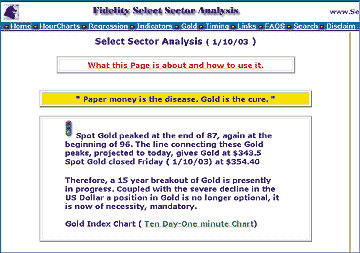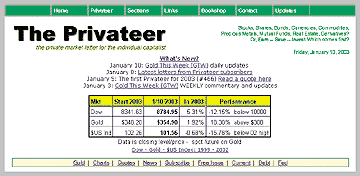![]()
SELECTSECTORS.COM

SelectSectors.com's commentaries and charts will give you an idea of the performance of various sectors, and the articles will help you gain insightful knowledge of broad market conditions.
Analyzing the performance of various sectors has always been a useful tool in market analysis. There are different ways to do this; SelectSectors.com looks at the various Fidelity Select sectors to determine performance. Why Fidelity sector funds? Because each portfolio represents a market sector, and a look at their performance will give you an idea of which sectors are showing strength and which are showing weakness.
Links to various sections of Select Sectors.com are displayed along the top of the homepage. There you will see daily commentary on various sectors, with an emphasis on the strongest-performing one. You will also see the chart of a specific sector that is currently worth monitoring with respect to current market conditions. Very short commentaries of broader indexes or sectors, along with general economic conditions, are also provided.
Although you have to scroll quite a bit before reaching the bottom of the site, I found it to have some interesting information worth viewing. For example, the statistics on the Standard & Poor's bear market were eye-opening. According to the data, the bear market from March 2000 to October 2002 suffered the largest losses in the S&P since 1957, which should be a cause for concern. The 1930?32 bear market gains in the Dow Jones Industrial Average (DJIA), and the duration of the rallies during that time, also provided significant information.
The site hosts a collection of interesting articles, some of which I printed for my own reference. I found most of the articles to be relevant reading material that lends itself to an understanding of current market conditions.
Other features available on the site include hourly charts of the different Fidelity sector funds. As you go through the site you will notice charts from some popular technical analysis sites such as BigCharts.com, StockCharts.com, and DecisionPoint.com. Regression tables, market indicators such as highs minus lows, and the summation index are also available on the site. These help in determining the direction of trends. An in-depth analysis of the strongest sector is included.
You will find long and short-term charts, commentary, articles (mostly from other websites), and charts that include some of the more popular indicators. The market commentary section contains information on why market timing is necessary and the different ways it can be applied.
Although the SelectSectors.com website may not win awards for best design, it contains information that traders will find useful. The commentaries and charts will give you an idea of the performance of various sectors, and the articles will help you gain insightful knowledge of broad market conditions.
-Jayanthi Gopalakrishnan, S&C Editor
THE-PRIVATEER.COM

If investing is a journey, then Bill Buckler - editor and publisher of the newsletter The Privateer - is more than happy to be your captain. As Buckler announces in his on-site bio, "From The Quarterdeck," there might be little in the way of his background or résumé that would make him appear a more capable steward of investment themes than those money managers who, in the midst of a raging bear market, have simply been losing clients' money hand over fist. Bill Buckler is no high-paid money manager, no investment guru, no self-appointed market visionary. He is a newsletter writer, a man who, when it comes to economics, considers himself "entirely self-taught." And like many of those who allow their learning to proceed at its own pace, Buckler's quest for knowledge has taken him to interesting places:
It is our misfortune to live in a "Dark Age" when it comes to the knowledge of the principles upon which economics in general and monetary theory in particular are built. It may seem paradoxical, but it is true, that the easiest way to understand any basic principle of human interaction is to start from the aspect of one man or woman in nature.
This starting place has produced in Buckler a unique perspective on economics and society - a perspective that very much forms The Privateer, "the private market letter for the individual capitalist." Readers and subscribers of The Privateer will not encounter page upon page of discussion about stock market earnings valuations methodologies or conversations with money managers still in denial after seeing their stock funds plummet by 36% or more. Instead, The Privateer takes its readers on a review of how the world works - how the value of money, the integrity of financial markets, and the often-overreaching hand of government collude to present both great opportunities and grave challenges not just for investors and traders, but for all of us.
In many ways, The Privateer reflects a view of the world that is little discussed in mainstream economics, on Wall Street, or on CNBC. Buckler's website and newsletter point to an increasingly fragile global financial structure supported largely by the ability of governments - especially the US government and its central bank - to generate credit. While credit in and of itself is no enemy of the economy (indeed, sound credit strengthens and extends the role of finance in the economy), increased rates of credit creation require either increased levels of growth or an increase in the supply of money - otherwise, the growth in credit is unsustainable. As Buckler suggested in a recent newsletter:
In the 1960s, 1970s, and 1980s, the main source of credit creation was government deficit spending. In the 1990s, the load was switched to consumer borrowing. Increasingly since 2000, the load has been borne by both consumer and government borrowing. Now, at the end of 2002, both consumer and government have their foot flat to the floor.
How we got into this position, how this position is changing, and what investors and traders can do in order to protect themselves and profit from this new situation in the financial markets and the economy is, in large part, the raison d'être of The Privateer.
FROM PORT TO STARBOARD
The Privateer website is divided into a number of sections; for example, a central section is The Privateer's Gold Pages. The section features a variety of essays on "Gold As Money," covering the fundamental economic role of money as well as the history of paper money. An interesting history of gold is provided in another set of essays that chronicle the changes in gold since gold ownership by Americans was prohibited (during the Great Depression) until the present day. A variety of datapoints on gold - from quotes and prices to charts and gold stocks - is also available on this page.
"Gold This Week" (GTW) is a separate commentary (available as a separate subscription, or free with a subscription to The Privateer) that includes both daily and weekly commentaries on the precious metal. Information such as comparative prices of gold - particularly comparison between the US dollar/Australian dollar price of gold (The Privateer is global in scope, but is Australia-based) and gold lease rates, both of which can be excellent indicators for gold price movement.
The Privateer's Chart Pages section includes long-term, regularly updated charts for both Australian and US equities markets. Especially helpful is The Privateer's own indexing of various Australian gold stocks, a project made necessary by the apparent discontinuation of the Australian Stock Exchange's gold index. Each chart - from Australia's All Ordinaries to the Dow Jones, Nasdaq, Standard & Poor's 500, and Nikkei - is accompanied by a sole indicator that changes periodically (for example, through December, "momentum" was the indicator of choice).
A companion section called the Quote Page provides stock market quotes from sources including DownloadQuotes.com, CBS Marketwatch, Multex Investor, and (for Australian equities) Sanford Securities. A News Page includes headlines from Reuters, the International Herald Tribune, USA Today, the Sydney Morning Herald, and an array of other news outlets. The headlines are arranged into four main categories: Fed Watch, Equities, Forex, and Commodities. That covers most of the market for heavily traded securities, be they stocks, currencies, or futures.
INVESTOR, EDUCATE THYSELF
The Privateer places great emphasis on education, both in terms of historical information (such that as provided on the Gold Pages) and contemporary economic information. Given the theoretical framework of The Privateer, much of this education surrounds the Federal Reserve Board and those government policies that encourage the creation of ever greater levels of debt. To this end, Debt Study receives its own section in The Privateer, and consists largely of what Buckler calls "A History Of The US Debt Ceiling Since 1940." Debt Study features charts, tables, and essays that relate to such topics as "US Debt From 1791," a "Dow Versus Debt Comparison," and a "stark" contrast between the US government's relationship to debt and deficit spending from 1900 to 1950 as compared to 1950?present.
A corollary to The Privateer's discussion on federal debt is the section on Alan Greenspan. Devoted to the man who has been the most celebrated central banker in economic history, the Greenspan section consists of speeches and excerpts from speeches made by Sir Alan Greenspan, chairman of the Federal Reserve Board since 1987. The section includes two key pieces that have become all the more worthwhile in the years since he first penned them. The first is his 1966 essay "Gold And Economic Freedom," which boldly and coherently argues the case for the gold standard. The second is Greenspan's famous "irrational exuberance" speech from 1996. Both are significant parts of modern economic history in the United States, and both are more relevant today given the growing concerns about the Fed's permanent revolution in monetary "accommodativeness" and long-term stewardship of the US economy. A Fed funds page, companion to the Greenspan page, chronicles the changes in the Fed funds rate since 1990.
THE PRIVATEER IN PRINT
But the big ship in the fleet of information that is The Privateer's website remains the newsletter. The Privateer is divided into a number of sections, including Global Report, which is an overview of some of the dominant themes in finance and economics in the US and around the world. A closer look at trends in the US is available, appropriately enough, in the Inside The United States section - and similar "insider" sections include a review of events in Japan, the European Union, and a special Australian report for those interested in issues relating to the land Down Under. Finally, a Global Market Report rounds out the newsletter with a revisiting of and extension on themes and issues introduced in the Global Report at the beginning of the publication.
The Privateer publishes 25 issues a year (often referred to as early and late monthly issues) and is available on a trial (five issues, $25), six-month (12 issues, $100), annual (25 issues, $180), and two-year (50 issues, $300) basis. (Free sample issues are available from the website.) Recent (early December) commentary from The Privateer included some hard-hitting discussion on the growing indebtedness of the US and how this problem is affecting relations with our trading partners. Another topic was the slow slide of the US manufacturing sector, as well as more thoughts on the ongoing deflation/inflation/credit excess debate. Many of the subjects are obviously mainstays of The Privateer's editorial beat, which manages to give the newsletter both an "insider" and a "man on the margin" perspective that is so often lacking in mainstream economic and financial commentary.
If you like the sense of being in the know, while at the same time feeling like more than just another member of the maddening crowd of retail investors, then get your sea-legs under you and consider signing on to The Privateer.
-David Penn, Staff Writer, STOCKS & COMMODITIES
Originally published in the March 2003 issue of Technical Analysis of STOCKS & COMMODITIES magazine. All rights reserved. © Copyright 2003, Technical Analysis, Inc.